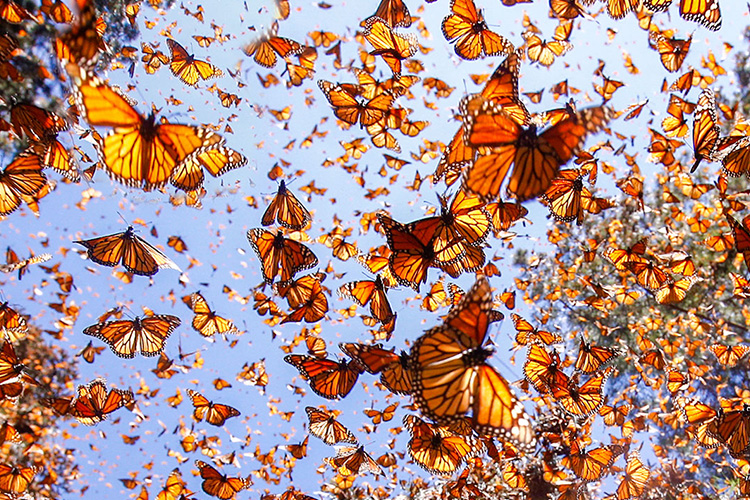
The annual gathering of thousands of monarchs continues to inspire scientists and their ever-growing research. photo by Sylvain Cordier
Scientists predict that the butterflies’ famous white spots may help the species travel longer distances.
In 1976, after 40 years of searching, Fred Urquhart discovered the specific locations in Mexico in which monarchs migrate in the winter. This discovery explained the many unanswered questions regarding the flight path of these insects.
The average monarch butterfly is born in the summer months and lives for around two to five weeks. Their main job is to reproduce and provide an opportunity for other monarchs to be born in late summer and early fall. These later-born monarchs have the ability to live an extra eight months in order to migrate to central Mexico in the winter. The newly-arrived monarchs then huddle together in large groups of trees. Those who hibernate throughout the winter produce the next generation of butterflies whose job is to travel back to the US and Canada in the summer months to begin the cycle again. The unfathomable idea that an insect no bigger than 10.5 centimeters could travel a distance up to 3,000 miles absolutely baffled scientists, but in 2023, they proposed an explanation for this rigorous journey.
The monarch butterfly is known for its vibrant orange color adorned with black and white spots around the edge of its wings. The primary use for its brilliant color scheme is to warn predators of its toxicity. The main diet of this species is milkweed which produces a toxin called cardiac glycosides. Cardiac glycosides can be damaging to predators like birds who sometimes consume monarchs. Along with the fiery orange base of the monarch butterfly comes white spots adorning the edges of its wings with a black background. Scientists began to notice a trend regarding the species’ famous migration and the size and quantity of these spots. With hundreds of monarch wings analyzed at different points of their migration, researchers noticed that those who got further on their journey had an average of three percent more white space on their wings. Researchers also analyzed species similar to the monarchs such as the Florida Queen butterfly and the Caribbean Queen butterfly who are both non-migratory. They found that these species have significantly fewer white spots. Scientists propose that the white spots could create a more efficient way for airflow to lift the butterflies mid-flight. Others propose that the spots help them avoid predators.
The monarch butterfly has been completing its migration to Mexico for years, and with an unknown future filled with global warming, this famous tradition may take a very different turn. Increases in global temperature can become hazardous to the monarch’s critical stages in hibernation, reproduction, and, most importantly, migration. More research is needed, so a definite answer regarding this hearty species of butterfly still has yet to come. However, the proposal of the correlation behind the monarch’s patterns and its immense flight pattern could be highly beneficial to future research and the species as a whole.